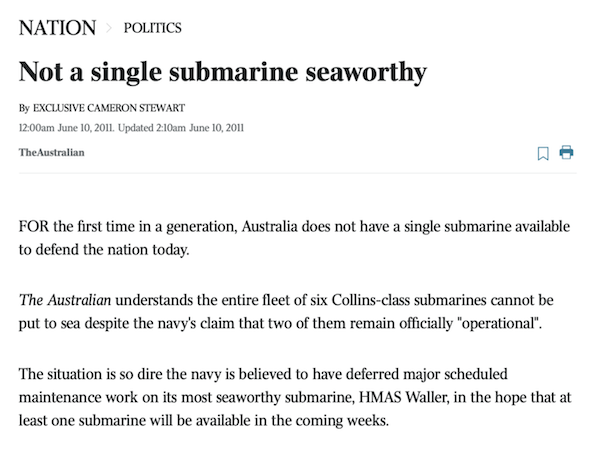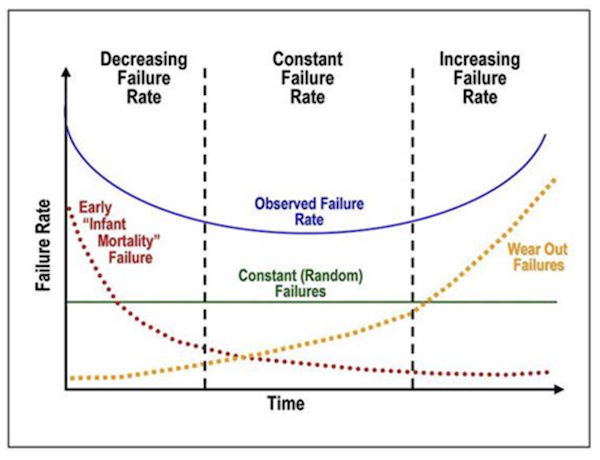It’s a $20B plus submarine mess, atop the well-known $368B AUKUS submarine mess-in-development. Rex Patrick lifts the lid on the little known financial and national security disaster that is the Collins Class submarines.
Last month, when The Australian reported that five of our six Collins Class submarine were out of action, the Chief of Navy, Admiral Mark Hammond, defended the subs, saying they remained “world class diesel boats” that were “meeting the operational requirements of the Australian government”.
It was a statement that was, at best, disingenuous.
What the admiral failed to say, and what is understood by few, perhaps not even by our bathtub admiral Defence Minister, is that Collins represents a more than $20B national security failure caused exclusively by incompetence.
A troubled life
The Collins submarines have been mired in controversy pretty much for all of their three-decade lives.
The Collins submarines were built in Adelaide between 1990 and 2003. They were plagued with problems at launch, not because of Australian build quality, but because Collins was a new design with a lot of teething issues.
“Dud subs” and “noisy as a rock concert” were labels attached to the submarine in 1998. The diesel engines were unreliable. Poor hydrodynamic design and propellor cavitation made the submarine noisy. The periscopes vibrated and the combat system didn’t work.
After considerable sums of taxpayer’s money were spent rectifying issues, the submarines proved capable, but unreliable.
On 10 June 2011 the Government woke up to a headline in the Australian; “not a single submarine seaworthy”. Reliability issues started to plague the Collins submarines.
Only after a detailed and brutal investigation, the ‘Coles review’, did submarine availability improve, but again at huge cost to the taxpayer. In the mid 2010’s Collins sustainment costs shot to well over $500M per annum.
Sustainment issues then saw the Collins class submarine listed as a Project of Concern from November 2008 until October 2017.
Australia was paying the price, and it has been a very considerable price, of choosing to have an orphaned submarine design; a submarine that no other nation was using and for which there were no international pool of spare parts.
Present day issues
This year’s allocated budget for sustainment of our Collins submarines is a ‘wallet sapping’ $769M. And for that, we’ve got just one submarine available for operations.
That’s not a reliable or credible military capability.
And whilst the Navy went into damage control when the current dire situation became public, this week Defence Industry Minister Pat Conroy placed the Collins submarines back on the Project of Concern List.
It is likely that the Collin-class will never come off that list. They’ll be on there until they are retired from service, and that could be sooner than the Navy would like and indeed potentially before their planned nuclear replacements are available.
Best laid plans o’ mice an’ men
Understanding the situation is not difficult. Anyone familiar with the life cycle of a car knows what Collins is going through.
When you first buy a car there’s a risk of infantile failure of components. The warranty period covers these failures. Then the car performs reliable for the next decade until wear-out failures start to kick in. That’s the point where most people dispose of the car.
There was a plan to rid the Navy of the Collins submarines before they hit the point where wear-out failures started to increase. It was a particularly important plan noting Australia was the only Collins spare parts source.
The first Collins submarine was supposed to retire in 2026.
Dunning-Kruger leadership at Defence
You do not have to be a scholar to work out that almost all of our Defence Force procurement screw-ups (and the list of screw-ups is long) start with a decision not to go with a low risk off-the-shelf solution.
And yet, that’s what happens over and over again. Defence leaders don’t look back and say, “what’s the key lesson from Defence procurement failures”, rather they think “I can do it better than the last guy”. It’s the Dunning-Kruger effect – a cognitive bias where people of limited ability in a particular domain, in this case project management, overestimate their abilities.
When the future submarine project was first announced in 2009, the plan was to have the first new submarine in the water by 2025, allowing the first Collins submarine to decommission in 2026.
Defence spent seven years from 2009 thinking it would embark on a risky ‘design your own Son-of-Collins’ project before announcing in 2016 that it would instead procure French nuclear submarines, converted into non-nuclear submarines.
Defence had injected 12 years of delay into a Collins submarine replacement and spent $4B buying nothing.
On the day the French submarine program was abandoned Defence had injected 12 years of delay into a Collins submarine replacement and spent $4B buying nothing.
Life-of-type-extension
Defence then recommended to Government that Australia embark on the $368B AUKUS program; a program that will unlikely ever see a delivery of a first US Virginia class submarine in 2035 as planned, and will most certainly not see a UK designed AUKUS submarine before 2040.
So, instead of decommissioning the first Collins submarine taxpayers will be hit with an additional $3B to $5B on a life-of-type extension (LOTE) for all six Collins boats. That cost estimate is from Defence and is a fantasy.
In May this year former US navy deputy assistant secretary Gloria Valdez handed a report to the Government stating that LOTE was a perilously high-risk endeavour that is not guaranteed to succeed. The taxpayers will likely be up for double the Defence LOTE estimate and there’s a real risk we’ll get nothing from it.
MWM has an Information Commissioner appeal afoot to get access to the Valdez report, which Defence is keeping secret – even from ASC, the Government shipyard charged with carrying out the LOTE.
And while the LOTE is underway, taxpayers will still be paying close to $800 million per annum to strive to have our 1990 Holden VN Commodore era Collins submarines at sea. That’s another $8.8B of originally unplanned spend to take us up to the unlikely arrival of a first nuclear powered submarine.
Meantime the risk of systemic failure for the Collins-class grows, raising the possibility that Australia could be left with no submarine capability at all.
Pure incompetence
Pure incompetence by Defence leaders has led us to a point in 2024 where we have a circa $20B bill on the table for failing Collins class submarine availability, as we simultaneously spend even more in what is likely to be a failed effort to acquire nuclear submarine capability.
All of this spend is supposedly designed to give us the capability to contribute to a China-Taiwan conflict predicted by the United States to likely take place later this decade.
Leaving aside the question of whether this is a sensible focus for Australian Defence planning and capabilities; if this were Australian Football League, Defence would have us paying for the most expensive football team ever, with the players scheduled to arrive after the grand final has been played.
The Albanese Government has blindly swallowed Defence’s Kool Aid. It’s hard to know whether Defence has spiked the Kool Aid and everyone attending the National Security Committee of Cabinet is drunk, or whether they’re all just plain dumb. It could even be a combination.
Meantime at the sharp end of national security, Australia’s highly professional and capable submariners are condemned to go to sea in elderly boats that may soon be no longer fit for purpose and perhaps worse.
Dumb Ways to Buy: Defence “shambles” unveiled – former submariner and senator Rex Patrick
Rex Patrick is a former Senator for South Australia and, earlier, a submariner in the armed forces. Best known as an anti-corruption and transparency crusader, Rex is also known as the "Transparency Warrior."



